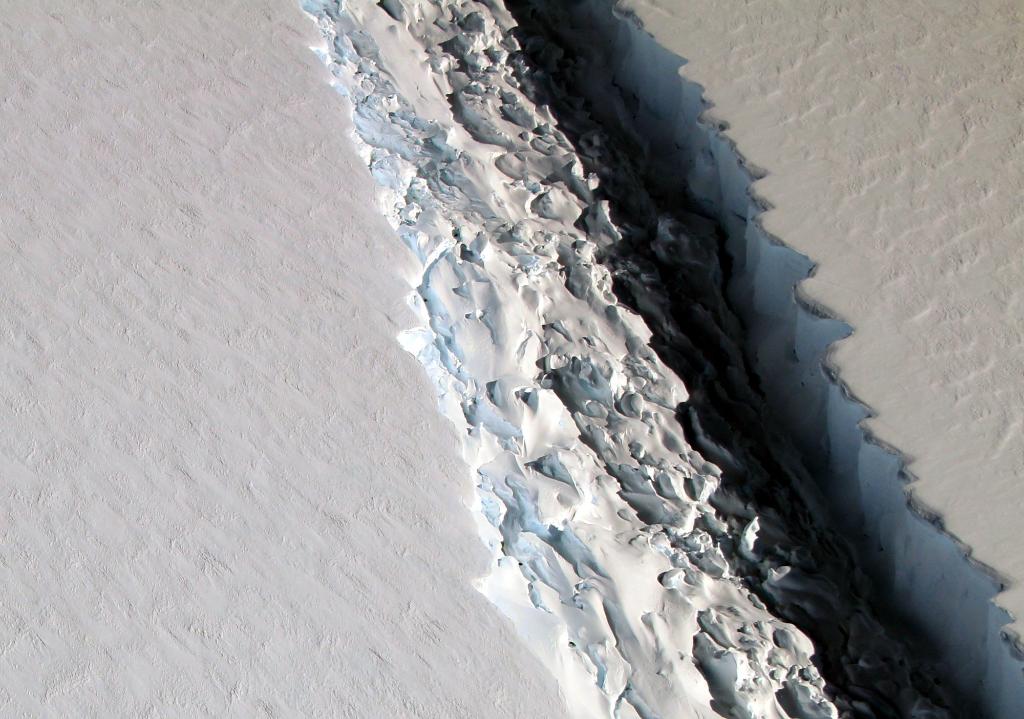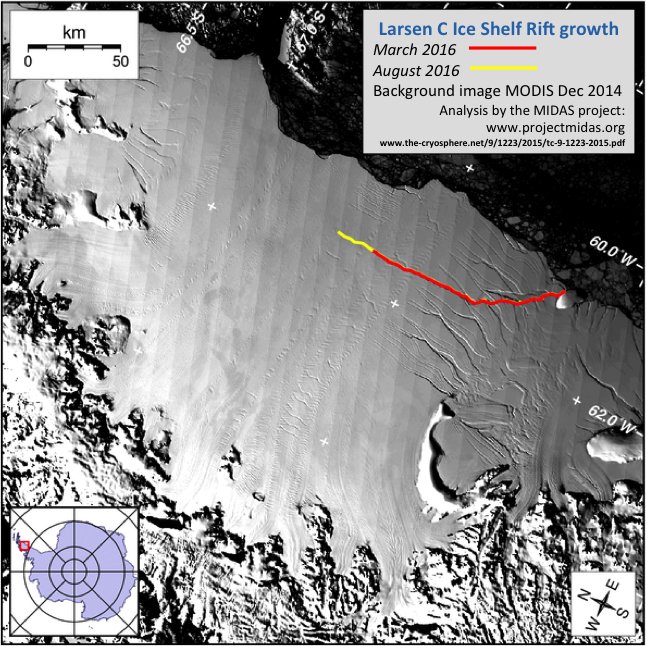
Rift in the Larsen C Ice Shelf as seen from a NASA aircraft on Nov. 10, 2016. Image: nasa/John Sonntag
The breakup of the massive Larsen C Ice Shelf in Antarctica is getting closer and will eventually produce an iceberg the size of Delaware prowling the Southern Ocean, according to new NASA data...
On Friday, NASA released an astonishing new image taken by researchers flying above the ice shelf on Nov. 10 showing the crack is getting longer, deeper and wider. Scientists think it will eventually cause a large section of the shelf to break off.
The scientists associated with a NASA field campaign known as Operation IceBridge measured the Larsen C fracture to be about 70 miles long, more than 300 feet wide and about a third of a mile deep.
SEE ALSO: With a collapsing West Antarctica, sea level rise may be twice as high as we thought
View is of a rift in the Antarctic Peninsula's Larsen C ice shelf from our airborne survey of polar ice: http://go.nasa.gov/2gT5w5F @NASA_ICE
When this iceberg calving event happens, likely within the next decade, it will be the largest calving event in Antarctica since 2000, the third biggest such event ever recorded and the largest from this particular ice shelf, scientists say.
Larsen C lies next to a smaller ice shelf that disintegrated in 2002 after developing a crack similar to the one now growing in Larsen C.

Map of Antarctica showing the amount of melting of ice shelves from below. Blue shades represent melt rates of greater than 5 meters (16.4 feet) per year. Arrow points to Larsen C Ice Shelf. Image: NASA/JPL-Caltech/UC Irvine/Columbia University
Ice shelves breaking off into icebergs don't directly increase sea levels, since their ice is already resting in the ocean like an ice cube in a glass.
However, because they act like doorstops to the land-based ice behind them, when the shelves give way, the glaciers can begin moving into the sea. This adds new water to the ocean and therefore increases sea levels.
The rift is likely to lead to an iceberg breaking off, which will remove about 10% of the ice shelf’s area
In the case of Larsen C, once the rift extends all the way across the shelf and breaks off the section of ice, a larger area of ice that is about the size of Scotland will destabilize and be at greater risk for melting, according to other research.
In August, a British research team monitoring the Larsen C Ice Shelf found that the rift had expanded by 14 miles between March and August of 2016. This was the fastest rate of expansion the researchers had observed.
Larsen B Ice Shelf before its breakup in 2002. Image: nasa
Larsen B Ice Shelf after its breakup in 2002. Image: nasa
The Larsen C Ice Shelf is the most northerly of the remaining major Antarctic Peninsula ice shelves. This part of Antarctica has been warming rapidly in recent years due to a combination of increasing air and sea temperatures.
The nearby Larsen B Ice Shelf made worldwide headlines in 2002 when it broke up after a similar process of rift-induced iceberg calving. The Larsen B event was featured in the opening scenes of the sci-fi climate change-related disaster film, The Day After Tomorrow.
BONUS: New Zealand's earthquake literally cracked the Earth open
Dec 3, 2016
source: http://mashable.com/
original story HERE
Get more of The Global Warming Blog. Bookmark this page and sign up for the blog’s free RSS Feed. Sign up for free Global Warming Blog by clicking here. You will automatically be emailed a regular summary of the latest global warming headlines.
To help do something about the climate change and global warming emergency, click here.
Sign up for our free Global Warming Blog by clicking here. (In your email, you will receive critical news, research, and the warning signs for the next global warming disaster.)
To share this blog post: Go to the Share button to the left below.







Be the first to comment
Sign in with